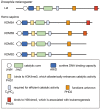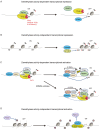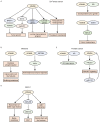Diverse Functions of KDM5 in Cancer: Transcriptional Repressor or Activator?
- PMID: 35805040
- PMCID: PMC9265395
- DOI: 10.3390/cancers14133270
Diverse Functions of KDM5 in Cancer: Transcriptional Repressor or Activator?
Abstract
Epigenetic modifications are crucial for chromatin remodeling and transcriptional regulation. Post-translational modifications of histones are epigenetic processes that are fine-tuned by writer and eraser enzymes, and the disorganization of these enzymes alters the cellular state, resulting in human diseases. The KDM5 family is an enzymatic family that removes di- and tri-methyl groups (me2 and me3) from lysine 4 of histone H3 (H3K4), and its dysregulation has been implicated in cancer. Although H3K4me3 is an active chromatin marker, KDM5 proteins serve as not only transcriptional repressors but also transcriptional activators in a demethylase-dependent or -independent manner in different contexts. Notably, KDM5 proteins regulate the H3K4 methylation cycle required for active transcription. Here, we review the recent findings regarding the mechanisms of transcriptional regulation mediated by KDM5 in various contexts, with a focus on cancer, and further shed light on the potential of targeting KDM5 for cancer therapy.
Keywords: KDM5; MYC; RNA polymerase II; cancer; epigenetic regulator; histone demethylase.
Conflict of interest statement
The authors declare no conflict of interest.
Figures





Similar articles
-
BRWD3 promotes KDM5 degradation to maintain H3K4 methylation levels.Proc Natl Acad Sci U S A. 2023 Sep 26;120(39):e2305092120. doi: 10.1073/pnas.2305092120. Epub 2023 Sep 18. Proc Natl Acad Sci U S A. 2023. PMID: 37722046 Free PMC article.
-
KDM5 Lysine Demethylases in Pathogenesis, from Basic Science Discovery to the Clinic.Adv Exp Med Biol. 2023;1433:113-137. doi: 10.1007/978-3-031-38176-8_6. Adv Exp Med Biol. 2023. PMID: 37751138
-
BRWD3 promotes KDM5 degradation to maintain H3K4 methylation levels.bioRxiv [Preprint]. 2023 Mar 28:2023.03.28.534572. doi: 10.1101/2023.03.28.534572. bioRxiv. 2023. Update in: Proc Natl Acad Sci U S A. 2023 Sep 26;120(39):e2305092120. doi: 10.1073/pnas.2305092120. PMID: 37034668 Free PMC article. Updated. Preprint.
-
KDM5 demethylases and their role in cancer cell chemoresistance.Int J Cancer. 2019 Jan 15;144(2):221-231. doi: 10.1002/ijc.31881. Epub 2018 Nov 26. Int J Cancer. 2019. PMID: 30246379 Review.
-
Functions and Interactions of Mammalian KDM5 Demethylases.Front Genet. 2022 Jul 11;13:906662. doi: 10.3389/fgene.2022.906662. eCollection 2022. Front Genet. 2022. PMID: 35899196 Free PMC article. Review.
Cited by
-
Engineering Oncogenic Hotspot Mutations on SF3B1 via CRISPR-Directed PRECIS Mutagenesis.Cancer Res Commun. 2024 Sep 1;4(9):2498-2513. doi: 10.1158/2767-9764.CRC-24-0145. Cancer Res Commun. 2024. PMID: 39194178 Free PMC article.
-
KDM5-mediated activation of genes required for mitochondrial biology is necessary for viability in Drosophila.Development. 2023 Nov 1;150(21):dev202024. doi: 10.1242/dev.202024. Epub 2023 Nov 6. Development. 2023. PMID: 37800333 Free PMC article.
-
Histone demethylase enzymes KDM5A and KDM5B modulate immune response by suppressing transcription of endogenous retroviral elements.bioRxiv [Preprint]. 2024 Sep 25:2024.09.23.614494. doi: 10.1101/2024.09.23.614494. bioRxiv. 2024. PMID: 39386707 Free PMC article. Preprint.
-
KDM5 family of demethylases promotes CD44-mediated chemoresistance in pancreatic adenocarcinomas.Sci Rep. 2023 Oct 25;13(1):18250. doi: 10.1038/s41598-023-44536-2. Sci Rep. 2023. PMID: 37880235 Free PMC article.
-
Histone demethylases in the regulation of immunity and inflammation.Cell Death Discov. 2023 Jun 23;9(1):188. doi: 10.1038/s41420-023-01489-9. Cell Death Discov. 2023. PMID: 37353521 Free PMC article. Review.
References
-
- Hanahan D. Hallmarks of Cancer: New Dimensions. Cancer Discov. 2022;12:31–46. doi: 10.1158/2159-8290.CD-21-1059. - DOI - PubMed
Publication types
Grants and funding
- 1 8 H 0 6 1 6 7, 1 9 K 2 1 2 7 6, and 2 0 K 0 8 7 3 4/Japan Society for the Promotion of Science
- NA/Mochida Memorial Foundation for Medical and Pharmaceutical Research
- NA/Shinnihon Foundation of Advanced Medical Treatment Research
- 18-25002/Princess Takamatsu Cancer Research Fund
- NA/Kobayashi Foundation for Cancer Research
- NA/Ichiro Kanehara Foundation for the Promotion of Medical Sciences and Medical Care
- NA/Japanese Society of Myeloma Research Award
- NA/Japanese Society of Hematology Research Grant
- NA/program of the Joint Usage/Research Center for Developmental Medicine, Institute of Molecular Embryology and Genetics, Kumamoto University
- NA/International Research Center for Medical Sciences grant for international collaborative research
- NA/Dana-Farber/Harvard Cancer Center SPORE in Multiple Myeloma Career Enhancement Award
LinkOut - more resources
Full Text Sources
Miscellaneous

